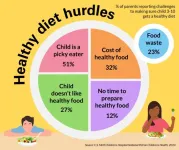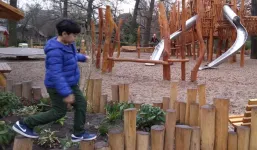(Press-News.org) Governments in the Mesoamerican Reef region are exploring the use of nature-based solutions to strengthen coral health and societal benefits for coastal communities. A new study led by Stanford researchers in collaboration with scientists from the World Wildlife Fund, the Healthy Reefs Initiative, and others from the Smart Coasts project quantified the outcomes of different watershed interventions to support coral health at regional versus national scales, and identified target areas that could improve both ecosystem and societal benefits nationally and across the region.
The nature-based approaches evaluated as key watershed (e.g., drainage area) interventions include ecosystem restoration or protection, and sustainable agriculture. Yet determining which areas to target for these interventions requires understanding the complex relationships between terrestrial and marine ecosystems, also known as “land-sea linkages,” their benefits to people, and the spatial scale being considered.
This work pushed the boundaries of how scientists analyze biophysical and ecological relationships, using cutting-edge optimization models (for the first time in a coastal context) of how to maximize benefits – and to whom – while meeting spatial or resource constraints.
“To restore nature – in this case, a large barrier reef – international collaborative actions at a large scale are what will really help,” said Jade Delevaux, the study’s lead author and senior fellow at Stanford’s Natural Capital Project. “At the same time, if you want to support coastal communities’ resilience by protecting properties and infrastructure along the coast or tourism-based livelihoods – you’re probably making decisions on a smaller scale.”
The research focused on illuminating some of these trade-offs for decision-makers and seeking places where there might be win-wins for the environment and people.
Land-sea connections
Healthy coral reefs provide essential economic, social, and environmental benefits to the communities that depend on them. These include coastal protection from storms, climate regulation, nature-driven tourism, and fisheries that feed communities.
While marine ecosystems can be affected by human activities in the ocean, like dredging or aquaculture, or natural hazards such as hurricanes, they are also affected by the health of upstream terrestrial ecosystems. Intensified deforestation in mangroves and tropical forests is a key factor, as it worsens pollution and carbon emissions on land. It also leads to sediment runoff from loss of their root systems, which harms downstream coastal water quality and consequently coral reef health.
The coastal and marine ecosystems of the Mesoamerican Reef stretch over 1,000 kilometers, establishing it as the largest transboundary barrier reef system in the Northern Hemisphere. Belize, Guatemala, and Honduras, three countries in the region, significantly affect the reef through human activities that impact the coastal watersheds. Yet these watersheds don’t always align with political boundaries, complicating policy interventions.
“It would be hard to justify, even scientifically, asking Guatemala or Honduras to finance watershed interventions if most of the benefits are accrued by the people in Belize,” said Delevaux. “That’s when we asked the question: if you were to manage watersheds with an eye towards supporting both people and climate resilience, would you target the same areas as you would if you were solely focused on coral reef health?”
Mapping benefits across scales
To answer that question, researchers and local partners identified target areas where three key watershed interventions could be implemented: restoration of agricultural land to native forest; protection of existing forest; and sustainable agriculture – converting conventional agriculture and ranching to agroforestry and silvopasture.
“It was amazing to see the level of coordination and collaboration happening while covering such a large geographic area. The communities’ knowledge, needs, and questions really influenced the science through the many workshops, participatory mapping exercises, and capacity trainings we held to gather the information for these analyses,” said Delevaux. “I’d say that part of the work was really inspiring, because you see how it’s going to be used firsthand.”
Then, using InVESTⓇ ecosystem services models, Delevaux and colleagues quantified the effects of different interventions in different target areas on coral health through sediment retention. They found that the most important target areas for coastal communities – where interventions would maximize societal benefits like tourism, fisheries, and coastal protection – changed depending on whether they prioritized a regional- versus national-scale scale approach.
Sediment retention and coral health improve the most in models prioritizing regional interventions that target larger, transnational watersheds. A national emphasis on smaller, non-transboundary watersheds lined by reefs provides more localized societal benefits.
“At the regional scale, across countries, we found we have the best opportunities for making investments in watersheds that are going to help reduce sedimentation and increase coral health across the region,” said Katie Arkema, senior fellow at the Natural Capital Project and senior scientist at the Pacific Northwest National Lab, with a joint appointment at the School of Marine Environmental Affairs at the University of Washington. “At the national scale, we can make investments that are going to really specifically benefit the coastal communities in that country through those societal ecosystem service benefits,” said Arkema.
While the study results show trade-offs between regional coral health and country-level societal benefits, there were also some interventions that prioritized similar target areas in both.
“These spatially explicit results are empowering for both local and regional managers. A donor or investor might be interested in improving reef health in a specific reef area or Marine Protected Area and could use these results to target the watersheds that yield maximum improvement in their focal area. A national government could determine the best set of interventions and watersheds that maximize both social and ecological benefits,” said Melanie McField, co-author, founder, and director of the Healthy Reefs for Healthy People Initiative.
“The model can also quantify the regional reef and social benefit to cooperative work in the major watersheds, supporting potential large-scale multi-national conservation efforts.”
Co-creating for the future
Researchers co-designed the study with local partners, including Healthy Reefs for Healthy People, and locally based affiliates of the World Wildlife Fund.
In Honduras, the results of the study are helping to guide investments in watershed restoration through replanting mangrove forests to minimize sediment runoff.
For Belizeans in Placencia, these results add to almost two decades of support for mangrove-forward development between the Natural Capital Project, WWF, Belize Coastal Zone Management Authority and Institute (CZMAI), and others. Delevaux also continues to work with communities in Placencia, Belize through an NSF project to find equitable nature-based solutions like mangrove restoration and conservation at the local level.
“It can be useful to emphasize for decision-makers that we do have some quantitative models and tools that can help support the kinds of decisions they have to make on where to direct funds. [Our research] can help provide insights into how the decisions that they make today might influence what happens in the future,” said Arkema.
Additional Stanford co-authors include ecosystem services analyst Jess Silver and senior GIS analyst Stacie Wolny, both affiliated with the Natural Capital Project. Additional co-authors are from Seascape Solutions LLC; the University of Washington; World Wildlife Fund-Mesoamerica; World Wildlife Fund, Mexico; World Wildlife Fund, Washington, D.C., USA; Sound GIS; Healthy Reefs for Healthy People; and Pacific Northwest National Laboratory.
This study was funded by the International Climate Initiative (IKI) Smart Coasts; the Gordon and Betty Moore Foundation; the National Science Foundation Coastline and People prime agreement; the Marianne and Marcus Wallenberg Foundation, the Summit Foundation, and CORESCCAM BNP-PARIBAS foundation.
END
Planning at multiple scales for healthy corals and communities
2024-04-22
ELSE PRESS RELEASES FROM THIS DATE:
U of T researchers map protein network dynamics during cell division
2024-04-22
An international team led by researchers at the University of Toronto has mapped the movement of proteins encoded by the yeast genome throughout its cell cycle. This is the first time that all the proteins of an organism have been tracked across the cell cycle, which required a combination of deep learning and high-throughput microscopy.
The team applied two convolutional neural networks, or algorithms, called DeepLoc and CycleNet, to analyze images of millions of live yeast cells. The result was a comprehensive map identifying where proteins are located and how they move and change in abundance ...
Pressure in the womb may influence facial development
2024-04-22
Physical cues in the womb, and not just genetics, influence the normal development of neural crest cells, the embryonic stem cells that form facial features, finds a new study led by UCL researchers.
The study published in Nature Cell Biology found that an increase in hydrostatic pressure sensed by the embryo can hinder the healthy development of facial features in mouse and frog embryos and in human embryoids (cell structures grown in the lab from human stem cells), suggesting that differences in pressure might affect the risk of facial malformations.
The ...
AI weather forecasts captured Ciaran’s destructive path
2024-04-22
Artificial intelligence (AI) can quickly and accurately predict the path and intensity of major storms, a new study has demonstrated.
The research, based on an analysis of November 2023’s Storm Ciaran, suggests weather forecasts that use machine learning can produce predictions of similar accuracy to traditional forecasts faster, cheaper, and using less computational power.
Published in npj Climate and Atmospheric Science, the University of Reading study highlights the rapid progress and transformative potential of AI in weather prediction.
Professor Andrew Charlton-Perez, ...
Feedback loop that is melting ice shelves in West Antarctica revealed
2024-04-22
Feedback loop that is melting ice shelves in West Antarctica revealed
New research has uncovered a feedback loop that may be accelerating the melting of the floating portions of the West Antarctic Ice Sheet, pushing up global sea levels.
The study, published in Science Advances, sheds new light on the mechanisms driving the melting of ice shelves beneath the surface of the ocean, which have been unclear until now.
The West Antarctic Ice Sheet has been losing mass in recent decades, contributing to global sea level rise. If it were to melt entirely, global sea levels would rise by around five meters.
It’s known that Circumpolar Deep Water (CDW), ...
How does aspirin help prevent colorectal cancer development and progression?
2024-04-22
Long-term daily use of aspirin can help to prevent the development and progression of colorectal cancer, but the mechanisms involved have been unclear. New research has revealed that aspirin may exert these protective effects by boosting certain aspects of the body’s immune response against cancer cells. The findings are published by Wiley online in CANCER, a peer-reviewed journal of the American Cancer Society.
To investigate the effects of aspirin (a nonsteroidal anti-inflammatory drug) on colorectal cancer, investigators in Italy obtained tissue samples from 238 patients who underwent surgery for colorectal cancer in 2015–2019, 12% of whom were aspirin ...
3 in 5 parents play short order cook for young children who don’t like family meal
2024-04-22
While most parents of preschool and elementary aged children strive to give their children a balanced, nutritional diet, some of their strategies to promote healthy eating may backfire, a national poll suggests.
A top example from the report: Three in five parents customize meals if their child doesn’t like what everyone else is eating.
Meanwhile, one in eight parents require children to eat everything on their plate, according to the University of Michigan Health C.S. Mott Children’s Hospital National Poll on Children’s Health. And while just one in three believe the standard American diet is healthy for kids, few have tried alternative, potentially more nutritional ...
Japan’s premodern concept of nature at root of distinctive mindset in early childhood education
2024-04-22
Osaka, Japan — Observers of Japanese early childhood education and care have pointed to the mindset of educators watching over and waiting on preschoolers as being an intriguing tendency. This mimamoru approach has its roots in a premodern concept of nature, according to Professor Yosuke Hirota at the Graduate School of Literature and Human Sciences of Osaka Metropolitan University.
Professor Hirota looked into the works of Sozo Kurahashi (1882-1955) and Kitaro Nishida (1870-1945) to see how this concept of nature from the past made its way into education in the present day. Kurahashi’s writing on ...
First Nations patients leave ED without completing treatment more than comparable non–First Nations patients
2024-04-22
First Nations patients in Alberta leave emergency departments (EDs) without completing treatment more often than comparable non–First Nations patients, due in part to anti-Indigenous racism expressed by providers, found new research published in CMAJ (Canadian Medical Association Journal) https://www.cmaj.ca/lookup/doi/10.1503/cmaj.231019.
Higher proportions of incomplete ED care for First Nations patients compared with non–First Nations patients occurred even in cases of serious diagnosis, and were found across all parts of Alberta. Provincially, 6.8% of First Nations visits end without completing ...
What do you know about measles and vaccination?
2024-04-22
With measles cases rising in Canada and internationally, it is important for clinicians to understand the disease and the role of vaccination against measles. Two practice articles in CMAJ (Canadian Medical Association Journal) https://www.cmaj.ca/lookup/doi/10.1503/cmaj.240415 https://www.cmaj.ca/lookup/doi/10.1503/cmaj.240371
provide succinct overviews of this highly infectious disease. Many clinicians may not have direct experience with measles diagnosis and treatment as Canada achieved measles elimination status in 1998.
“The increase in measles activity globally and in Canada is a reminder of the importance of immunization. ...
Giant galactic explosion exposes galaxy pollution in action
2024-04-22
A team of international researchers studied galaxy NGC 4383, in the nearby Virgo cluster, revealing a gas outflow so large that it would take 20,000 years for light to travel from one side to the other.
The discovery was published today in the journal Monthly Notices of the Royal Astronomical Society.
Lead author Dr Adam Watts, from The University of Western Australia node at the International Centre for Radio Astronomy Research (ICRAR), said the outflow was the result of powerful stellar explosions in the central regions of the galaxy that could eject enormous amounts of hydrogen and heavier elements.
The ...



